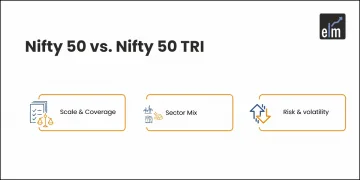Investors frequently make the error of asking, “Which are the best stocks to buy for long-term investments?” But rather than asking what to buy, investors should do their research and pick stocks for long term investment in India.
By doing their research, investors will learn to select the best stocks for investment. In the long term, simple enterprises with clear business models prove to be wealth producers.
One of the best methods to expand your money over the long run and reach your financial objectives is by investing, but you shouldn’t go into it expecting to become wealthy right away. History demonstrates that using a long term strategy is the most reliable way to build money.
The best method to deal with market volatility is to remain patient. The stock market can fluctuate in unpredictably positive and negative ways. A patient investing strategy puts excellent company acquisition and long term holding first.
Long term investors can achieve big financial advantages in this way without having to spend a lot of time agonising over their holdings.
In today’s blog, let us discuss some steps to pick the best stocks for long term investment. But before that let us discuss some important things one should know before we dive into steps into how to pick stocks for long term investment.s in India-
Table of Contents
What is Long Term Investing?
When you keep an investment for a year or more or longer, it is referred to as long term. Long term mutual fund investment plans are those that have been held for three years or more. Stocks, equities mutual funds, and other securities can be very volatile in the near term. Holding the investment for an extended period of time is one strategy to reduce risk.
Depending on your objectives, this can take three, five, ten, twenty, or even more years. The long-term helps your money grow more quickly, resulting in a sizable corpus for your ambitions. It also works as a cushion against short-term market volatility.
If you are investing in stocks for long term investments, you should first define your goals and know what fundamental analysis is-
1. Define Your Investment Goals and Risk Tolerance
Have a comprehensive understanding of your financial objectives before beginning picking stocks for long term investment. Any investment’s main goal is to help you accomplish a particular goal. Therefore, it is doubtful that you will succeed in the challenges associated with long-term investing unless you have a clear understanding and vision of your goals.
Sort your objectives into three general categories: short, medium, and long-term. While medium-term goals often take three to five years to complete, short-term goals typically have a time horizon of six months to a year. Long-term objectives, on the other hand, have a time horizon of at least ten years.
Knowing your objectives can help you determine how much money will be needed to reach them. It will aid in financial organisation and, more crucially, maintain your motivation to put money aside and make investments. So go back to the drawing board, write down your life goals, assess your finances, and start moving forward.
2. Conduct a Fundamental Analysis
If you are selecting stocks for long term investment, it’s important to do a fundamental analysis. By taking into account the economic and financial variables that determine a market’s underlying worth, the fundamental analysis aims to pinpoint markets that are under or overpriced.
If you want to choose stocks using fundamental research, there are a few measures to do. First, remember that the main goal of fundamental analysis is to determine the intrinsic value of a stock.
This implies that you should study both qualitative and quantitative aspects of the economy, as well as the various economic sectors and the individual businesses that comprise each sector. Let us take the case study of Reliance Industries Ltd. for a better understanding-
a. Qualitative Analysis
Qualitative factors to consider include:
1. Company News
Stock prices can go up or down in response to news about the business you want to invest in. This is because people frequently buy stocks in response to positive news while selling them in response to negative news. Supply and demand are impacted, which eventually affects the share price.
2. Personnel changes
Personnel changes, especially management restructures, are crucial for stock investors to understand since they impact how the market perceives them. Any personnel changes could have an impact on the company’s reputation, which directly affects stock prices.
3. Financial events
When choosing stocks, it’s critical to consider financial events because they might increase market volatility and unpredictability. Interest rate decisions, planned management changes, and significant occurrences like Brexit are examples of economic events.
b. Quantitative Analysis
Quantitative factors include:
1. Earnings releases
As part of their fundamental analysis, traders and investors should keep a close eye on changes in corporate earnings. The stock price might not accurately reflect the company’s value if earnings decline and the share price does not react to the new level of earnings.
2. Balance sheets
All of a company’s assets and liabilities will be listed on the balance sheet. Because it shows earnings potential, a better balance sheet typically translates into a stronger stock price. As previously noted, earnings have a direct impact on stock prices.
3. Dividends
A part of a company’s profit that it chooses to distribute as dividends to its shareholders. One way a shareholder can profit from an investment without having to sell shares is through these.
Dividends are a deciding element in-stock selection since they show that a firm is profitable and has a strong likelihood of generating future earnings.
4. Ratios
Eight simple ratio analysis techniques may be used to visualise a company’s entire operations and predict where its valuation may be in the future-
The ratios are as follows:
- P/E Ratio: The Price-Earnings Ratio or the P/E is obtained by dividing the current price of a company’s share by the Earnings Per Share(EPS) of the company. It provides a clear picture of the amount of money that investors would be willing to invest in a share of a company, for every rupee of its earnings.
- Debt-Equity Ratio: This financial ratio provides an understanding of the relative proportion of the debts that have been accrued to finance the company’s assets and the shareholders’ equity in the company. It is represented by dividing the total debt of the company by the shareholders’ equity.
- Earnings per share(EPS): EPS is the most widely used ratio as an indicator to measure a company’s profitability. It is obtained by dividing the net profit of a company by the number of outstanding shares.
- Return on Equity: Return on Equity(ROE) serves as a great instrument to measure the financial performance of a company by dividing the net income of the company by the shareholders’ equity. ROE is considered to be the return on net assets since the shareholders’ equity is obtained by taking away the debt from the company’s assets.
- Price-to-Book Value Ratio: Price-to-book value ratio gives a larger picture of the company’s current market value, as compared to its book value. It indicates how the company has performed over the years and indicates whether the company is overvalued or undervalued.
- Dividend-to-price ratio: It is a percentage used to exhibit how much a company pays out in dividends every year, as a percentage of its stock price. It is calculated by dividing the annual dividends per share by the Current share price in the market.
- Working Capital Ratio: The ability to pay off short-term liabilities(to be repaid within the next 12 months) with the current assets are often an indicator of the liquidity of the company. The working Capital Ratio is obtained by dividing the Current Liabilities by the Current Assets of the company. A low Working Capital ratio is often a Red signal in the financial market. As a general rule of thumb, a 2:1 ratio is always preferred.
- Quick Ratio: Quick ratio is almost similar to Working Capital Ratio, except for the fact that the Quick Ratio considers the firm’s liquidity in terms of current assets, without considering Inventory. Hence, it gives a reflection on the ability of the firm to pay the current liabilities without having to sell its inventory.
Having understood the two important things that every investor should know before they start the process of selecting stocks for long term investment, let us now discuss how you select the best stocks-
Ways of Selecting Best Stocks for Long Term Investment
Below are the ways for selecting best stocks for long term investment in India-

1. Screen Stocks using Fundamental Scans
Investors can sort and filter through firms based on their financial parameters with the aid of a fundamental stock screener. Investors can choose stocks based on a variety of fundamental and technical indicators by utilising this stock screener.
For instance, a stock screener can help investors find businesses that have the right P/E ratio if they are seeking equities with low P/E ratios.
Additionally, the fundamental stock screener can assist investors in conducting thorough research on specific stocks, enabling them to make wise investment choices. Investors can discover trends, examine the past performance of the stock, and compare a company’s financial indicators and performance to other businesses in the same industry.
2. Pick Stocks according to Investment Themes
You can also pick stocks according to the investment themes that are currently prevailing in the market. For example, if the crude prices are up, then you select those which will benefit when the crude prices rise-
3. Based on Investment Ideas
You can also pick long term stocks for investment using the investment ideas section in StockEdge. In this section, users will get a list of stocks that the StockEdge Analyst Team is optimistic about and the case studies prepared on them along with an overview of the related Spider Chart, Edge Score points, Key Level and Gap.
On clicking on any stock in the Investment Ideas section-lets take the example of Zomato Ltd., a user will be redirected to the Edge Chart with the Case Study Levels plotted on them. These levels relate to the Support and Resistance levels for a stock on the basis of the latest case study published on it.
A single green line denotes a single support price level, whereas a green-shaded region on the graph denotes a support price range.
Similar to how a single brown line denotes a single resistance price level, a brown-shaded range denotes a resistance price range. Through this tool, users can gain a sense of a stock’s support and resistance levels. In our example-Zomato has support levels of 38-42 and resistance levels of 75-82.
4. Technical Analysis
You can also select stocks for long term investment based on technical analysis. Technical analysis for stocks analyses information on previous price movements and general market sentiment to forecast future price changes for a stock.
It is not surprising that some investors are drawn to technical analysis to help them make investment decisions because making accurate predictions is a crucial component of successful investing.
For picking stocks for long term investment, one can use technical analysis scans such as monthly breakout and 52 weeks high scans–
Above are the 4 simple ways that investors can easily use for selecting the best stocks for a long-term investment with the help of StockEdge.
Conclusion
It’s crucial to choose equities that complement your risk-management plan. Since equities are constantly impacted by outside forces, all markets involve some level of risk because the trade may not always perform as anticipated.
When choosing equities, you may run into hazards including outdated business models, bad management choices, and new rivals. Additionally, there is general market risk and exchange rate risk, both of which are crucial to take into account if you plan to invest in foreign stocks.
Learn more about Fundamental Analysis, by joining our course on Stock Investing Made Easy
Frequently Asked Questions (FAQs)
Which are the best stocks for long term investment in India?
Because of the intense competition in the stock market, everyone wants to get rich. However, you must be careful about the research you conduct when earning money. If you’re looking for advice on how to pick best stocks for long term investment in India, look into stocks! Do not blindly believe any market predictions you receive. Make sure you investigate the investment thoroughly before investing any money.
How do you choose stocks for long term investment?
Examining a stock’s historical earnings and predicted future earnings is one technique to decide if it is a wise long term investment. A corporation may be an excellent long term investment if its track record of increasing earnings over several years is steady.
Which stocks to buy for 10 years in India?
One can choose stocks with good management such as Reliance Industries- Multinational Conglomerate, Tata Consultancy Services (TCS)-Information Technology., Infosys-Information Technology, HDFC Bank- Banking for investing for 10 years in India.






